- Clone
- 500A2 (See other available formats)
- Regulatory Status
- RUO
- Other Names
- CD3ε, T3, CD3
- Isotype
- Syrian Hamster IgG
- Ave. Rating
- Submit a Review
- Product Citations
- publications
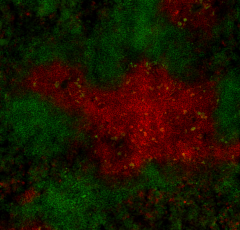
-

BALB/c mouse frozen spleen section was fixed with 4% paraformaldehyde (PFA) for 10 minutes at room temperature and blocked with 5% FBS for 1 hour at room temperature. Then the section was stained with 5 µg/ml of CD3ε (clone 500A2) Alexa Fluor® 647(red), and 5 µg/ml of B220 (clone RA3-6B2) Alexa Fluor® 488 (green) at 4°C overnight. The image was scanned with a 10X object and stitched with MetaMorph® software.
| Cat # | Size | Price | Quantity Check Availability | Save | ||
|---|---|---|---|---|---|---|
| 152319 | 25 µg | 100€ | ||||
| 152320 | 100 µg | 184€ | ||||
CD3ε is a 20 kD transmembrane protein, also known as CD3 or T3. It is a member of the Ig superfamily and primarily expressed on T cells, NK-T cells, and at different levels on thymocytes during T cell differentiation. CD3ε forms a TCR complex by associating with the CD3δ, γ and ζ chains, as well as the TCR α/β or γ/δ chains. CD3 plays a critical role in TCR signal transduction, T cell activation, and antigen recognition by binding the peptide/MHC antigen complex.
Product DetailsProduct Details
- Verified Reactivity
- Mouse
- Antibody Type
- Monoclonal
- Host Species
- Syrian Hamster
- Immunogen
- Mouse T cell receptor.
- Formulation
- Phosphate-buffered solution, pH 7.2, containing 0.09% sodium azide.
- Preparation
- The antibody was purified by affinity chromatography and conjugated with Alexa Fluor® 647 under optimal conditions.
- Concentration
- 0.5 mg/ml
- Storage & Handling
- The antibody solution should be stored undiluted between 2°C and 8°C, and protected from prolonged exposure to light. Do not freeze.
- Application
-
IHC-F - Quality tested
- Recommended Usage
-
Each lot of this antibody is quality control tested by immunohistochemical staining on frozen tissue sections. For immunohistochemistry, a concentration range of 5.0 - 10 µg/ml is suggested. It is recommended that the reagent be titrated for optimal performance for each application.
* Alexa Fluor® 647 has a maximum emission of 668 nm when it is excited at 633 nm / 635 nm.
Alexa Fluor® and Pacific Blue™ are trademarks of Life Technologies Corporation.
View full statement regarding label licenses - Excitation Laser
-
Red Laser (633 nm)
- Application Notes
-
Clone 500A2 antibody is able to partially cross-block the 17A2 and 145-2C11 antibodies, indicating that all three of these anti-CD3 antibodies recognize distinct but overlapping epitopes.
-
Application References
(PubMed link indicates BioLegend citation) -
- Miescher GC, et al. 1989. Immunol. Lett. 23:113.
- Product Citations
-
- RRID
-
AB_2750181 (BioLegend Cat. No. 152319)
AB_2750182 (BioLegend Cat. No. 152320)
Antigen Details
- Structure
- Ig superfamily, forms CD3/TCR complex with CD3δ, γ and ζ subunits and TCR (α/β and γ/δ), 20 kD.
- Distribution
-
Thymocytes (differentiation dependent), mature T cells and NK-T cells.
- Function
- TCR signal transduction, T cell activation and antigen recognition.
- Interaction
- T-cell receptor (TCR).
- Ligand/Receptor
- Peptide antigen/MHC-complex.
- Cell Type
- NKT cells, T cells, Thymocytes, Tregs
- Biology Area
- Cell Biology, Immunology, Signal Transduction
- Molecular Family
- CD Molecules, TCRs
- Antigen References
-
1. Barclay A, et al. 1997. The Leucocyte Antigen FactsBook Academic Press.
2. Davis MM. 1990. Annu. Rev. Biochem. 59:475.
3. Weiss A, et al. 1994. Cell. 76:263. - Gene ID
- 12501 View all products for this Gene ID
- UniProt
- View information about CD3epsilon on UniProt.org
Related Pages & Pathways
Pages
Related FAQs
Other Formats
View All CD3ε Reagents Request Custom Conjugation| Description | Clone | Applications |
|---|---|---|
| APC anti-mouse CD3ε | 500A2 | FC |
| FITC anti-mouse CD3ε | 500A2 | FC |
| PerCP/Cyanine5.5 anti-mouse CD3ε | 500A2 | FC |
| PE/Cyanine7 anti-mouse CD3ε | 500A2 | FC |
| PE anti-mouse CD3ε | 500A2 | FC |
| APC/Fire™ 750 anti-mouse CD3ε | 500A2 | FC |
| Alexa Fluor® 700 anti-mouse CD3ε | 500A2 | FC |
| Purified anti-mouse CD3ε | 500A2 | FC,IHC-F,Block |
| Alexa Fluor® 594 anti-mouse CD3ε | 500A2 | IHC-F,3D IHC |
| Alexa Fluor® 647 anti-mouse CD3ε | 500A2 | IHC-F |
| Alexa Fluor® 488 anti-mouse CD3ε | 500A2 | FC,IHC-F,3D IHC |
| APC/Cyanine7 anti-mouse CD3ε | 500A2 | FC |
Compare Data Across All Formats
This data display is provided for general comparisons between formats.
Your actual data may vary due to variations in samples, target cells, instruments and their settings, staining conditions, and other factors.
If you need assistance with selecting the best format contact our expert technical support team.
-
APC anti-mouse CD3ε

C57BL/6 splenocytes were stained with FITC CD19 and APC CD3ε... 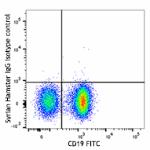
-
FITC anti-mouse CD3ε

C57BL/6 mouse splenocytes were stained with CD19 APC and FIT... 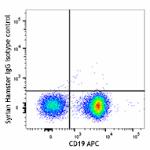
-
PerCP/Cyanine5.5 anti-mouse CD3ε

C57BL/6 mouse splenocytes were stained with CD19 APC and CD3... -
PE/Cyanine7 anti-mouse CD3ε
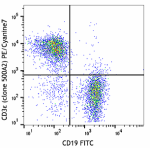
C57BL/6 mouse splenocytes were stained with CD19 FITC and CD... -
PE anti-mouse CD3ε

C57BL/6 splenocytes were stained with CD19 FITC and CD3ε (c... 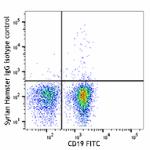
-
APC/Fire™ 750 anti-mouse CD3ε

C57BL/6 mouse splenocytes were stained with CD19 FITC and C... -
Alexa Fluor® 700 anti-mouse CD3ε
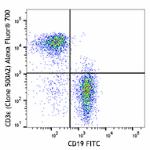
C57BL/6 splenocytes were stained with CD19 FITC and CD3ε (c... -
Purified anti-mouse CD3ε
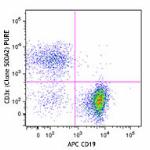
C57BL/6 splenocytes were stained with purified CD3ε (clone 5... 

C57BL/6 mouse frozen spleen section was fixed with 4% parafo... -
Alexa Fluor® 594 anti-mouse CD3ε
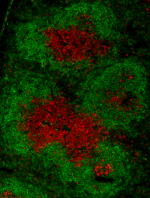
C57BL/6 mouse frozen spleen section was fixed with 4% parafo... 
Paraformaldehyde-fixed (4%), 500 μm-thick mouse spleen secti... -
Alexa Fluor® 647 anti-mouse CD3ε

BALB/c mouse frozen spleen section was fixed with 4% parafor... -
Alexa Fluor® 488 anti-mouse CD3ε

C57BL/6 splenocytes were stained with CD19 APC/Cyanine7 and ... 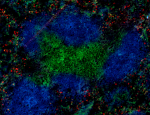
Balb/C mouse frozen spleen tissue slices were fixed with 4% ... 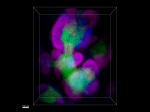
Paraformaldehyde-fixed (4%), 500 μm-thick mouse spleen secti... -
APC/Cyanine7 anti-mouse CD3ε

C57BL/6 mouse splenocytes were stained with Alexa Fluor® 488...
 Login / Register
Login / Register 













Follow Us